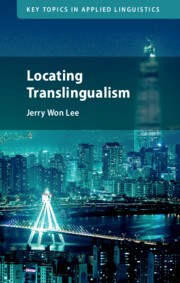Book contents
- Locating Translingualism
- Key Topics In Applied Linguistics
- Locating Translingualism
- Copyright page
- Dedication
- Contents
- Figures
- Acknowledgments
- Notes on the Text
- Introduction
- 1 Translingualism and the Locations of Culture
- 2 Locating Global Korea
- 3 Encountering the Unfamiliar: Languaging Culture
- 4 Visible Nation: Scaling Culture
- 5 Semiotic Excess: Tracing Culture
- Conclusion: More Locations of Culture
- References
- Index
1 - Translingualism and the Locations of Culture
Published online by Cambridge University Press: 31 March 2022
- Locating Translingualism
- Key Topics In Applied Linguistics
- Locating Translingualism
- Copyright page
- Dedication
- Contents
- Figures
- Acknowledgments
- Notes on the Text
- Introduction
- 1 Translingualism and the Locations of Culture
- 2 Locating Global Korea
- 3 Encountering the Unfamiliar: Languaging Culture
- 4 Visible Nation: Scaling Culture
- 5 Semiotic Excess: Tracing Culture
- Conclusion: More Locations of Culture
- References
- Index
Summary
This chapter introduces a framework of translingual inversion, which facilitates our effort to make sense of the ways in which a given culture can be rendered visible across global space. “Translingual inversion” describes both a theoretical heuristic by which to inquire into what may be the core semiotic features of a given cultural imaginary, which distinguish it from another cultural imaginary, and also the phenomenon of recognizing such features, of locating culture. The application and understanding of translingual inversion are made possible by adopting a global locus, but also “obliquely.” Due to the fact that a given culture typically need not be expected to differentiate itself from other cultures on an everyday basis, translingual inversion is about making sense of the ways in which culture can be located across global space. This chapter also outlines some of the complexities inherent to semiotically representing a particular kind of culture, namely the national imaginary, and then briefly describe how translingual inversion can therefore be instrumental to the task of “locating” national imaginaries across global space.
Keywords
- Type
- Chapter
- Information
- Locating Translingualism , pp. 28 - 53Publisher: Cambridge University PressPrint publication year: 2022

